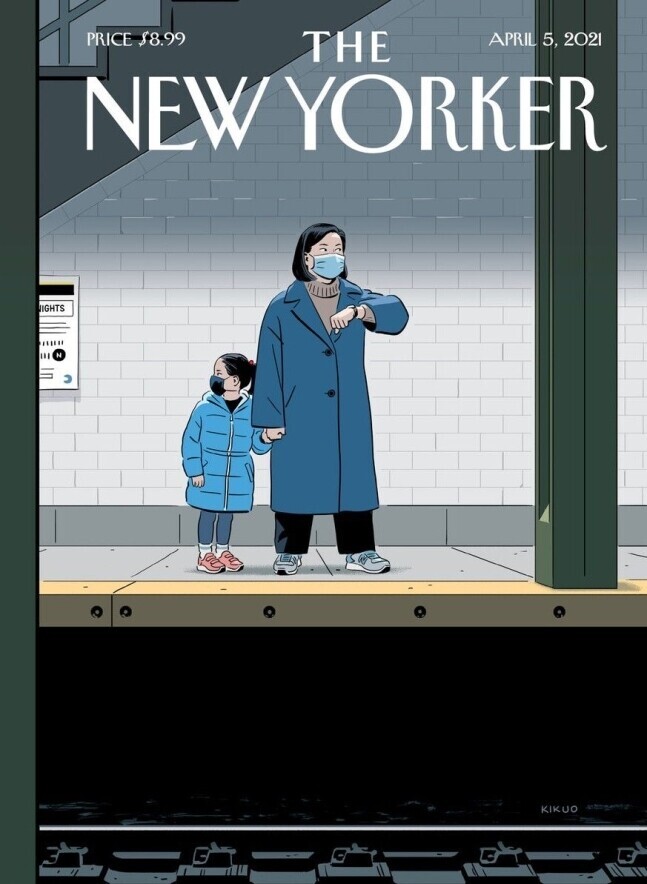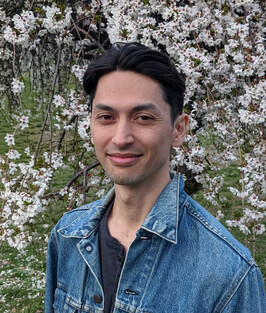hankyoreh
Links to other country sites 다른 나라 사이트 링크
[Interview] New Yorker illustrator says Asian Americans need recognition

An Asian mother-daughter duo waits for a train on a subway platform in New York City. The mother, whose gesture indicates a sense of unease, raises her eyebrows while her daughter remains aware of her surroundings. There is no apparent danger in the illustration, but the image’s viewer hopes the pair makes it to their destination safely.
The illustration, titled "Delayed," is the cover for the April 5 issue of the New Yorker by Asian American cartoonist R. Kikuo Johnson. Since its publication, the cover has been lauded for its portrayal of the anxiety Asian Americans feel following anti-Asian attacks.
In an email interview with the Hankyoreh Wednesday, Johnson said, "I wanted [the mother-daughter pair] to be very alert and anxious without appearing overtly fearful."
Johnson's illustration resonated with many in the US. Korean American author Jenny Han tweeted, "The way R. Kikuo Johnson captures this moment and simultaneously breaks my heart." The New Yorker, in an interview piece with the cartoonist, called the image "a delicate balancing act, all about timing and tension."

Johnson, born and raised on the island of Maui in Hawaii, has been living in Brooklyn, New York, since 2016, working mostly on editorial illustrations. He took on the recent project following the March 16 shootings in Atlanta. He said he started by revisiting news coverage of anti-Asian hate crimes one article at a time.
"So many mothers and grandmothers have been targeted, many on the subway. I imagined my own mom in that situation. I thought about my grandma and my aunt, who have been among my greatest sources of support," the cartoonist said.
Johnson said that Asian hate is relatively invisible, as the discourse on race has predominantly been about black vs. white.
For instance, US authorities have yet to label the Atlanta spa shootings a hate crime. A local police officer instead mentioned "sex addiction" as a possible motive behind the shootings.
Johnson wanted to bring the issue of Asian hate to light.
"There is no single image that will speak to everyone, but I hope some people feel seen and recognized by the cover. Asian American issues are seldom addressed in broader American culture. I just hope people find truth in the image," he said.

Here is the full text of the interview with Johnson over his recent work for the New Yorker.
Hankyoreh (Hani): Why did you decide to draw a cover based on the horror that Asian Americans have recently experienced?
R. Kikuo Johnson: I've been doing covers for the New Yorker since 2016, and following the shootings in Atlanta, the art editor of the magazine, Françoise Mouly, called me and asked me if I had any ideas for a cover dealing with Asian American discrimination. I spent the next two days sketching and generating as many ideas as I could, hoping that I might help bring some of these issues to light.
Hani: How did you come up with this particular image of an Asian mother and daughter standing on the New York subway platform?
Johnson: I began preparing for this project by revisiting news coverage of anti-Asian hate crimes committed during the pandemic. As I absorbed one account after another, they became increasingly difficult to read. So many mothers and grandmothers have been targeted, many on the subway. I imagined my own mom in that situation. I thought about my grandma and my aunt, who have been among my greatest sources of support. The mother in the drawing is made up of all these women.
Hani: Are there any details in the drawing that you particularly cared about?
Johnson: The gesture of the two characters was the thing that required the most reworking. I wanted them to be very alert and anxious without appearing overtly fearful. In most cases, I found that omitting details was more important than including them. My original sketch included a bench along with the usual trash scattered around the stations of the New York Subway system. Removing all extraneous detail seemed to make the situation feel more stark and ominous.
Hani: You said you "tried a different approach ranging from angry calls to action to celebrations of pride" for the cover. Can you tell us more?
Johnson: The recent attacks on Asians filled me with so many emotions. They made me enraged, so sad, and also so proud of my heritage, all at the same time. I tried different sketches for all the different emotions I was feeling. I felt a lot of pressure to get this one right. Sometimes I have to see all the possibilities before I can understand what's right for the moment.
Hani: It seems like you are avoiding stereotypes for Asians in your drawing.
Johnson: My goal every time I draw people is to make them feel as alive as possible. It's less about making them look naturalistic and more about making them feel alive. Cliches and stereotypes often make the figures feel plastic and predictable.
Hani: What message do you want to send to your fellow Americans through your work?
Johnson: The Asian American community is so large and diverse, there is no single image that will speak to everyone, but I hope some people feel seen and recognized by the cover. Asian American issues are seldom addressed in broader American culture. I just hope people find truth in the image.
Hani: Do you know anyone personally who has experienced or felt threatened by Asian hate?
Johnson: All my Asian women friends in NYC who I have spoken to recently have expressed some anxiety about being attacked, especially while walking alone or taking the subway. Some have begun to carry pepper spray.
Hani: Six Asian women were killed in a recent shooting in Atlanta. In New York, there was a series of attacks on Asian women. At a Korean convenience store, a man shouted, "Go back to China." Why do you think this is happening?
Johnson: Asian Americans have always been the targets of xenophobia in America. Recent years have seen increased tribalism, political partisanship and racial division for all Americans. The political right frequently used China as a scapegoat for pandemic casualties in America, and this rhetoric appears to have exacerbated and expanded anti-Asian sentiment.
Hani: Racism toward Asian Americans has long been ignored in the United States. Do you see this changing anytime soon?
Johnson: In America, race is overwhelmingly discussed in terms of black vs. white. Asian Americans consistently confound that narrative in so many statistical categories, but there is enormous political interest from both parties, keeping the discussion bipolar. Perhaps the current spate of anti-Asian hate will change that.
By Lim Jae-woo, staff reporter
Please direct comments or questions to [english@hani.co.kr]

Editorial・opinion
![[Column] Season 2 of special prosecutor probe may be coming to Korea soon [Column] Season 2 of special prosecutor probe may be coming to Korea soon](https://flexible.img.hani.co.kr/flexible/normal/500/300/imgdb/original/2024/0426/3317141030699447.jpg) [Column] Season 2 of special prosecutor probe may be coming to Korea soon
[Column] Season 2 of special prosecutor probe may be coming to Korea soon![[Column] Park Geun-hye déjà vu in Yoon Suk-yeol [Column] Park Geun-hye déjà vu in Yoon Suk-yeol](https://flexible.img.hani.co.kr/flexible/normal/500/300/imgdb/original/2024/0424/651713945113788.jpg) [Column] Park Geun-hye déjà vu in Yoon Suk-yeol
[Column] Park Geun-hye déjà vu in Yoon Suk-yeol- [Editorial] New weight of N. Korea’s nuclear threats makes dialogue all the more urgent
- [Guest essay] The real reason Korea’s new right wants to dub Rhee a founding father
- [Column] ‘Choson’: Is it time we start referring to N. Korea in its own terms?
- [Editorial] Japan’s rewriting of history with Korea has gone too far
- [Column] The president’s questionable capacity for dialogue
- [Column] Are chaebol firms just pizza pies for families to divvy up as they please?
- [Column] Has Korea, too, crossed the Rubicon on China?
- [Correspondent’s column] In Japan’s alliance with US, echoes of its past alliances with UK
Most viewed articles
- 1After election rout, Yoon’s left with 3 choices for dealing with the opposition
- 2Two factors that’ll decide if Korea’s economy keeps on its upward trend
- 3Why Kim Jong-un is scrapping the term ‘Day of the Sun’ and toning down fanfare for predecessors
- 4Noting shared ‘values,’ Korea hints at passport-free travel with Japan
- 5AI is catching up with humans at a ‘shocking’ rate
- 6South Korea officially an aged society just 17 years after becoming aging society
- 7Korea’s 1.3% growth in Q1 signals ‘textbook’ return to growth, says government
- 8‘We must say no’: Seoul defense chief on Korean, USFK involvement in hypothetical Taiwan crisis
- 9Exchange rate, oil prices, inflation: Can Korea overcome an economic triple whammy?
- 10Japan officially says compensation of Korean forced laborers isn’t its responsibility